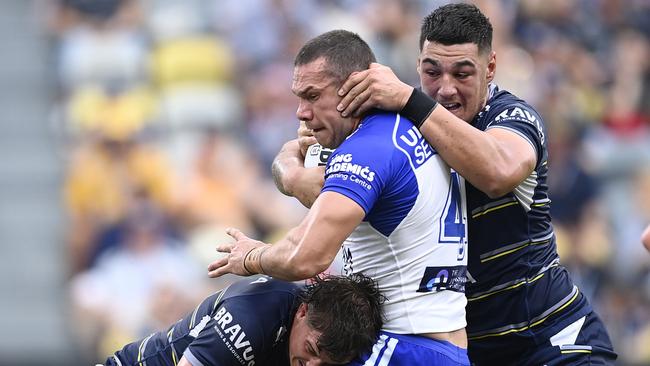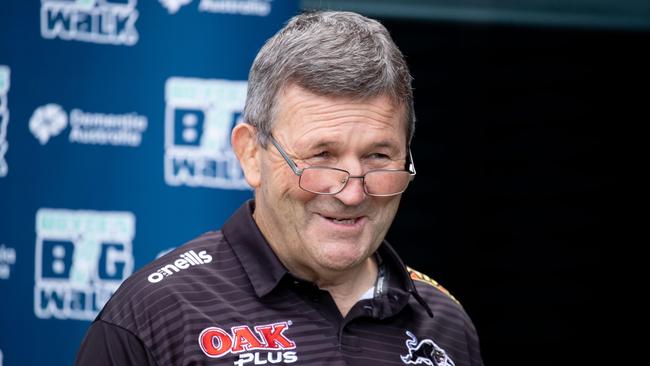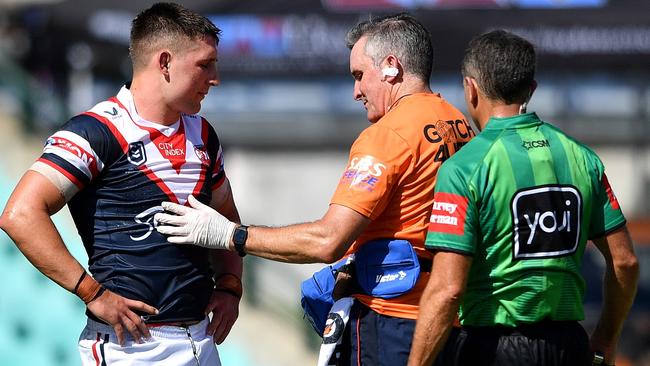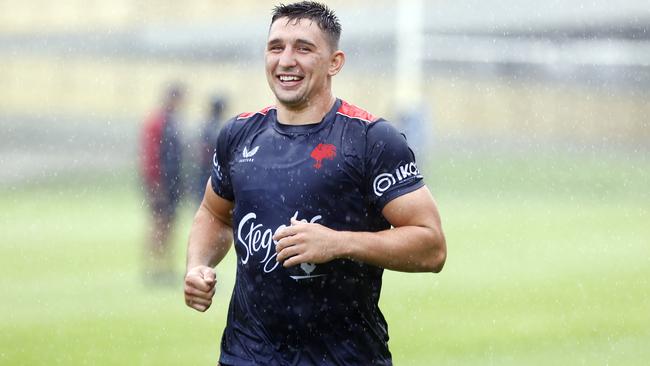Paul Kent: Coaches brought the NRL concussion rule crackdown on themselves
The new concussion guidelines have every team on warning, and NRL coaches don’t have far to look when it comes to apportioning blame, PAUL KENT writes.

NRL
Don't miss out on the headlines from NRL. Followed categories will be added to My News.
The confusion in Brent Naden’s face was there to see.
The trainer had a great hold of his sleeve and was edging him towards the sideline even as Naden protested, because he wanted to stay on.
Concussion? Oh, he felt fine, at least that was certainly what he was indicating.
It did not seem to matter that moments before Naden got his head in a horribly bad position and fell backwards out of the tackle with one eye going north and the other going west.
Concussion plays all sorts of tricks on the brain.
Naden recovered on the ground and by the time he got to his feet he was ready again for battle, such is the toughness of the rugby league player.
Stream every game of every round of the 2022 NRL Telstra Premiership Season Live & Ad-Break Free In Play on Kayo. New to Kayo? Try 14-Days Free Now >

Few athletes can stand with them in this area.
The world is changing, though, and the recent awareness of brain injury, and the devastation it causes, has created a position that is without dispute.
Already over the summer Johnny Raper, a league Immortal, died from the effects of dementia.
There was also the upsetting news that Royce Simmons, more cult figure than Immortal, revealed he was in the early stages of dementia.
Simmons grew his legend when he got knocked out for NSW and climbed to his feet before falling on his face again. He was tripping over things that weren’t there.
He was named man of the match after the game and could not remember a minute of it.
Each new diagnosis means the game simply has no choice but to treat concussions seriously.
And while it makes you feel for Naden, who was about to be short-changed in one of his club’s bravest victories, the alternative is simply too bad to imagine.
The Bulldogs were down on men and holding on to a 6-4 lead like it was good money.
In the end the 18th man had to be activated, such was the carnage.

The new guidelines have every team on warning.
They were not dreamt up in some morning conference over summer, but are part of an international consensus on concussion in sport.
A category one concussion, which Naden suffered, has obvious visual signs.
The indicators are a player laying motionless, suffering motor incoordination, an impact seizure, a blank or vacant look or the lack of a protective action.
He falls, in other words, and doesn’t brace or protect himself.
Suffer any of these and the player is replaced immediately and not allowed to return.
This was why Victor Radley was replaced.
Radley went down and was temporarily motionless.
Not long enough for coach Trent Robinson, who afterwards claimed Radley did not suffer a concussion but was reacting to a neck injury.
Maybe so.
Yet even as he argued that Radley should not have been replaced, Robinson began to argue against himself.

“I think it is right what they’re trying to put in, but you have to be careful,” Robinson said after the game.
“It’s frustrating at the moment.
“They’ve made a call on how to get rid of the cheating of the system, which we all acknowledge was there.”
The Daily Telegraph conducted a survey over the summer revealed three out of four NRL coaches believed the old system was being rorted.
Clubs were doing it two ways.
In some instances, players were faking shoulder injuries or neck injuries to disguise they had a concussion and to stay on the field. One player was known for standing up and bending over and holding his knee while his head cleared.
On the flip side, clubs were also faking concussions to healthy players to get free interchanges.

It depended on the position played.
Middle forwards at some clubs suffered head knocks around the 18-22 minute mark with alarming regularity. Along with their eight legal replacements, these clubs were having as many 14 to 15 replacements a game as players needed to be assessed.
It left some club doctors sucking their thumbs in the corner.
Enough that, privately, the NRL has responded to claims from the club doctors saying they were sick of being caught in the middle, being pressured by coaches to clear players to continue playing, even though everything they saw meant a concussion and the player should be replaced.
The new system needs to be quicker and the NRL will move to ensure that.
But the alternatives seem few.
More Coverage
Originally published as Paul Kent: Coaches brought the NRL concussion rule crackdown on themselves





